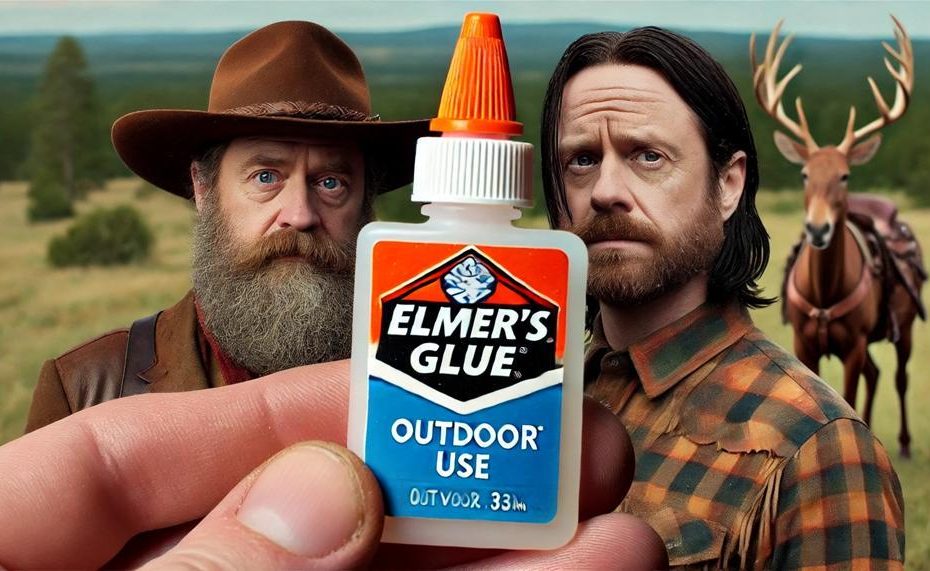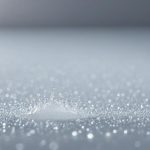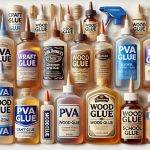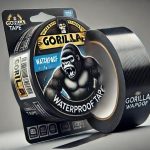No, regular Elmer’s glue should not be used outdoors or in environments where it may get wet. Here’s an attention-grabbing introduction that covers the key points:
Elmer’s glue – that classic white, non-toxic adhesive we all grew up with for arts and crafts. But can this childhood staple withstand the great outdoors? Short answer: not really. While Elmer’s is perfect for indoor projects, using it outside is a recipe for disappointment. Here’s why:
• Regular Elmer’s glue is water-soluble, meaning it can dissolve and lose its sticking power when exposed to moisture.
• It may seem to dry into a waterproof coating at first, but that bond won’t last if it gets rained on or submerged in water.
• For outdoor applications that require true water resistance, you’ll need to look for specialty adhesives designed for that purpose.
In this blog post, we’ll explore:
- The science behind why Elmer’s glue isn’t waterproof
- Situations where you can (cautiously) use it outside
- Easy hacks to make basic Elmer’s more water-resistant
- Waterproof glue alternatives ideal for outdoor projects
Whether you’re a crafter, DIYer, or just nostalgic for that iconic glue smell, stick around to learn when Elmer’s is your friend, and when you need a heavy-duty waterproof option.
Table of Contents
What Is Elmers Glue?
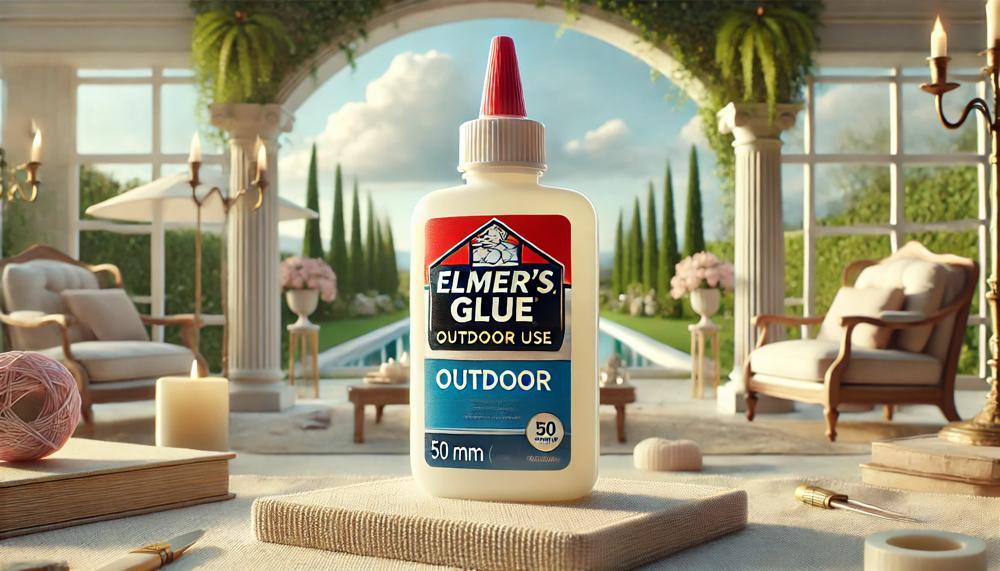
The primary ingredients in Elmer’s School Glue are polyvinyl acetate and aliphatic resins. These contribute to the glue’s effectiveness as follows:
| Ingredient | Role | Outdoor Effectiveness |
|---|---|---|
| Polyvinyl acetate | Forms a strong, flexible bond when dry, adhering porous materials like paper, wood, and fabric | Limited water resistance, not suitable for prolonged outdoor exposure or submersion |
| Aliphatic resins | Enhance adhesion and provide additional binding strength | Some water-resistant properties but not waterproof |
While Elmer’s School Glue is versatile and suitable for various indoor crafts and projects, it is not recommended for outdoor use or applications requiring waterproofing. The polyvinyl acetate and aliphatic resins provide decent adhesion and limited water resistance, but the glue can dissolve or degrade when exposed to moisture or submerged in water over time.
For outdoor projects or waterproofing applications, Elmer’s offers specialized products like Elmer’s Glue-All Max, which claims to be waterproof and suitable for outdoor use. However, even these products may only withstand light rain or splashback and should not be fully submerged in water for extended periods.
Ultimately, while Elmer’s School Glue is a trusted and versatile adhesive for indoor projects, it is not designed for prolonged outdoor exposure or waterproofing applications.
Water-Soluble Nature of Elmers Glue
| Is Elmer’s Glue Water-Soluble? | Yes, Elmer’s glue is water-soluble, which makes it easy to clean up and safe for children to use. | Its water-soluble nature is due to its primary ingredients, polyvinyl acetate and aliphatic resins. |
| Can It Withstand Outdoor Conditions? | Elmer’s glue has limitations when used outdoors due to its susceptibility to moisture and humidity. | It is vulnerable to UV rays, which can cause it to degrade and lose its adhesive properties over time. |
| Alternatives for Outdoor Projects | For more durable and long-lasting outdoor projects, specialized outdoor adhesives like epoxy resin and construction adhesive are recommended. | These adhesives are designed to withstand harsh weather conditions, moisture, and UV exposure, providing a stronger and more reliable bond. |
While Elmer’s glue can be used for some outdoor projects, its water-soluble nature and lack of UV resistance make it less suitable for challenging outdoor conditions.
Temperature Range for Elmers Glue Bonding
The recommended temperature range for using Elmer’s glue outside is below 80°F (26.7°C). According to the research, Elmer’s Glue-All white glue starts to lose its bond strength at temperatures above 80°F due to the glass transition temperature of the polyvinyl acetate (PVAc) polymer used in the formulation.
| Temperature Range | Bonding Performance |
|---|---|
| Below 80°F (26.7°C) | Optimal bonding |
| Above 80°F (26.7°C) | Bond strength diminishes |
This information was confirmed by the company when contacted, emphasizing the importance of using Elmer’s glue within the recommended temperature range for successful and durable bonds. Higher temperatures can cause the adhesive to soften, compromising its ability to form a strong and lasting bond.
Elmer’s glue is a water-based adhesive, making it susceptible to moisture and UV exposure, which can further degrade its performance in outdoor applications.
UV Rays and Elmers Glue Performance
UV rays from sunlight can severely degrade the performance of Elmer’s glue when used outdoors. The ultraviolet radiation breaks down the chemical bonds within the glue, causing it to lose its adhesive properties over time. This process, known as photodegradation, can lead to the glue becoming brittle, cracking, and ultimately failing to hold materials together effectively.
| UV Exposure | Effect on Elmer’s Glue | Potential Solutions |
| Short-term exposure | Minimal impact on adhesion | Use UV-resistant coatings or shading |
| Prolonged exposure | Significant bond weakening, cracking, and peeling | Consider UV-resistant adhesives or alternative bonding methods |
While Elmer’s glue may initially bond materials well, its performance can deteriorate rapidly when subjected to continuous outdoor UV exposure. The intensity and duration of sunlight, as well as the type of materials being bonded, can influence the rate of degradation.
Photodegradation not only weakens the adhesive strength but can also cause discoloration, fading, and an overall loss of structural integrity.
To mitigate the effects of UV rays, it is advisable to explore alternative adhesives specifically designed for outdoor use or to apply protective coatings that block UV radiation. Shading or covering the bonded area can also help prolong the lifespan of Elmer’s glue in outdoor applications.
Protective Sealant as a Solution
The crux of the matter is that employing a protective sealant can significantly bolster the durability of Elmer’s glue when utilized outdoors. Here’s a comprehensive elucidation:
Shielding from UV Rays
Ultraviolet radiation from the sun is the primary culprit behind the deterioration of Elmer’s glue when exposed to outdoor conditions. A transparent, UV-resistant sealant acts as an impenetrable barrier, deflecting these harmful rays and preventing photodegradation.
UV radiation can break down chemical bonds, leading to the breakdown of materials like adhesives.
Moisture Resistance
Many protective sealants are formulated to be water-resistant or waterproof, shielding the underlying glue from moisture and humidity. This attribute is crucial for outdoor applications, as moisture can cause the glue to lose its adhesive properties and potentially lead to mold growth.
Moisture can weaken the bond strength of adhesives, making a protective sealant essential for outdoor use.
Enhanced Durability
Beyond shielding against UV rays and moisture, protective sealants often possess superior durability compared to the glue itself. They are formulated to withstand the rigors of outdoor environments, including temperature fluctuations, abrasions, and impacts, further extending the lifespan of the bonded materials.
Sealants can protect against environmental factors that degrade adhesives over time.
In essence, a meticulously applied protective sealant acts as an impregnable fortress, safeguarding Elmer’s glue from the relentless onslaught of the elements.
Specialized Outdoor Adhesives
| Material | Recommended Outdoor Adhesive | Key Features |
| Metal, Concrete, Stone | Epoxy Adhesive | High strength, water and chemical resistant, gap-filling capabilities, suitable for heavy-duty bonding. |
| Plastic, Rubber, Vinyl | Polyurethane Adhesive | Flexible, durable, bonds uneven surfaces, resists cracking and peeling, good UV resistance. |
| Wood, Ceramics, Glass | Cyanoacrylate (Super Glue) | Quick-setting, waterproof, suitable for small repairs or lightweight materials, fills gaps and bonds tight fits. |
When venturing outdoors, selecting the appropriate adhesive is paramount for a long-lasting, weatherproof bond. Epoxy adhesives reign supreme for heavy-duty metal, concrete, or stone projects, boasting unparalleled strength, water resistance, and gap-filling prowess.
For flexible materials like plastic or rubber, polyurethane adhesives shine, bonding uneven surfaces while resisting cracking, peeling, and UV degradation. Cyanoacrylates, or super glues, offer a swift and trusty solution for minor repairs on wood, ceramics, or glass, seamlessly waterproofing and filling tight crevices. With the right outdoor adhesive, your creations will withstand nature’s whims, from scorching sun to relentless rain.
Conclusion
While Elmer’s glue evokes nostalgic memories of childhood crafts, its water-soluble nature makes it ill-suited for the great outdoors. Like a fair-weather friend, this classic adhesive simply can’t withstand moisture, UV rays, or temperature extremes. When exposed to the elements, Elmer’s bond weakens and degrades, leaving your project a disappointing, unstuck mess.
However, all is not lost for those seeking an outdoor glue solution. With a few clever hacks, you can bolster Elmer’s resilience. Applying a protective sealant forms a waterproof, UV-resistant shield around the glue, significantly increasing its outdoor longevity. Imagine your bonded surfaces encased in an impenetrable fortress, defying rain, sunlight, and extreme temps.
For heavy-duty outdoor projects, though, specialty adhesives are the way to go. Epoxies, polyurethanes, and cyanoacrylates are specifically engineered to withstand nature’s punishing conditions while providing a tenacious, weatherproof grip. From concrete to rubber, wood to metal, these industrial-strength glues form bulldog bonds that just won’t quit.
So embrace Elmer’s for all your indoor arts and crafts, but when braving the outdoors, strategically choose the right adhesive armor.

